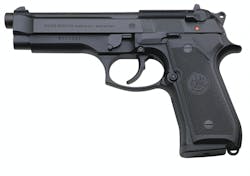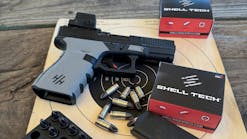The Beretta 92F: Legendary Lawman Weapons Next Evolution
January 14th, 1985 is a noteworthy day for the United States military. Some would even call it dubious. On this day the United States Army adopted the Beretta 92F as their sidearm choice, designating it the M9. I will not delve into the politics of such a decision. That subject would be full of conjecture and, in some cases, anger. Let us just say that the 9mm Beretta won out over the Sig P226 due to cost issues and replaced the 1911 because civilians said it should.
The Beretta Model 92 is a 9mm semi-automatic pistol that has a double-action first trigger pull, followed by a single-action trigger pull for subsequent rounds. The "F" and "FS" (for Federal) models have a safety lever that also functions as a de-cocking lever. It is fed by a 15 round staggered detachable box magazine. The FS designation indicates an enlarged hammer pin that was the response to failures supposedly resulting from firing sub-machinegun rounds, more on this later.
Due to the sheer numbers that the military was ordering and the fact that these new pistols were being manufactured in Accokeek, Maryland it was a foregone conclusion that this pistol would be adopted by police departments (especially in Maryland). This was a major reason for the high capacity 9 mm becoming so popular in law enforcement. I have to say up front that I’ve never been a fan of the Beretta 92/M9. The ergonomics never suited me and I took umbrage to the replacement of the 1911 (especially since I enlisted in the NAVY in March 1985). That being said, the Beretta 92 was subjected to an enormous beating during the military trials including firing 35,000 rounds. Only the Sig Sauer and the Beretta passed all the qualifications. I know that many feel that S&W got shafted during the trials (and I agree) but that discussion could take and entire article all by its lonesome so I chose not to go into it here.
During the first phase of issue there were three reports of locking block failures by Navy Special Warfare Group operators with one civilian production pistol and two first production run 92s. The injuries were lacerations to the face and one broken tooth (nobody died). There have been “reports” of the Navy using sub-machine gun rounds that caused these failures. By all official accounts the rounds in question were standard M882 pistol ammunition firing a 124 grain bullet at 1113 feet per second. The Navy notified all branches of the military as well as Beretta and the Army began their own tests. Of the three civilian market M92SB pistols the Army had for testing, one was showing cracks. They continued to fire all three to failure with the cracked pistol firing 23,310 rounds before the slide let go and the other two reached 30,083 and 30,545 rounds. It was determined that there was a metallurgy issue with the Italian made slides. After finally admitting there was an issue, Beretta redesigned the locking block so that in the event of a failure, the slide would be unable to fly off the rails. No reports of this type of failure have been reported in any of the Maryland production guns.
This isn’t to say that there haven’t been some issues; the Berettas do require some basic maintenance and don’t particularly like cheap non-Beretta magazines. Some officers have had failure to feed and failure to eject problems. More often than not this has been traced back to a lack of cleaning and improper lubrication. Not that ANY officer would not take care of their primary firearm. As much as I say I don’t particularly life the Berettas, I have to admit that I’ve put thousands of rounds through them, with the exception of some bad ammunition, had never had any problems with reliability. I didn’t particularly like the first round double action trigger pull but replacing the main spring with the 92D (double action only) piece helped clean it up considerably.
Recently there have been reports of magazine issues down range in Iraq and Afghanistan. While some of these may be the result of the overall condition of the issued M9, most of these problems can be traced back to the issue magazines from Checkmate Industries. I’m not going to place any blame on Checkmate at this point as I’ve had a few of their M9 magazines myself and never had issue but it seems that the parkerized finish collects fine sand particles and can result in stuck mags or stuck followers. This particular finish is done to military specification so the contract didn’t take into account the effect the Middle Eastern sand would have on the components. Live and learn. Hopefully. In 2006 the specs were changed to a dry film lubricating type for the Airtonic Services contract. While this finish doesn’t wear as well Parkerizing it doesn’t have the sand issues. Checkmates newer magazines have the current finish also.
The popularity of this pistol has spawned several variations. These include the 92D (double-action only), the 92 Inox (for inoxizable– Italian for not oxidized), the A1 variation (with accessory rail), the Compact series and the updated 90-TWO. Many police departments have adopted the polymer Px4 series of pistols that, according to Beretta, feature a unique rotating barrel and locking system dissipates recoil energy radially, reducing felt recoil and muzzle rise. All of the features and models shown above have also been integrated into the most popular police caliber (as of this writing), the .40 Smith & Wesson, breathing new life into a 30 + year old design. Like it or not the Beretta design has proven to be quite robust. While many in the military and law enforcement would prefer another caliber (.45 anyone?) it’s hard to argue with 15 rounds of anything.

Charles Bennett
Charles Bennett was born in our Nation's Capital and grew up in the Maryland suburbs. Mr. Bennett has been working in all aspects of the publishing industry since the late 1980s primarily in the fields of commercial photography and magazine production. Moving to California in 1992 to attend college resulted in B.F.A and Masters degrees. California also supplied Mr. Bennett with his wife. The two of them are avid sports persons and participate in shooting, scuba diving, surfing, running and bicycling. As a long time hobby Mr. Bennett has studied the legends of American law enforcement which led to his writing these columns.



